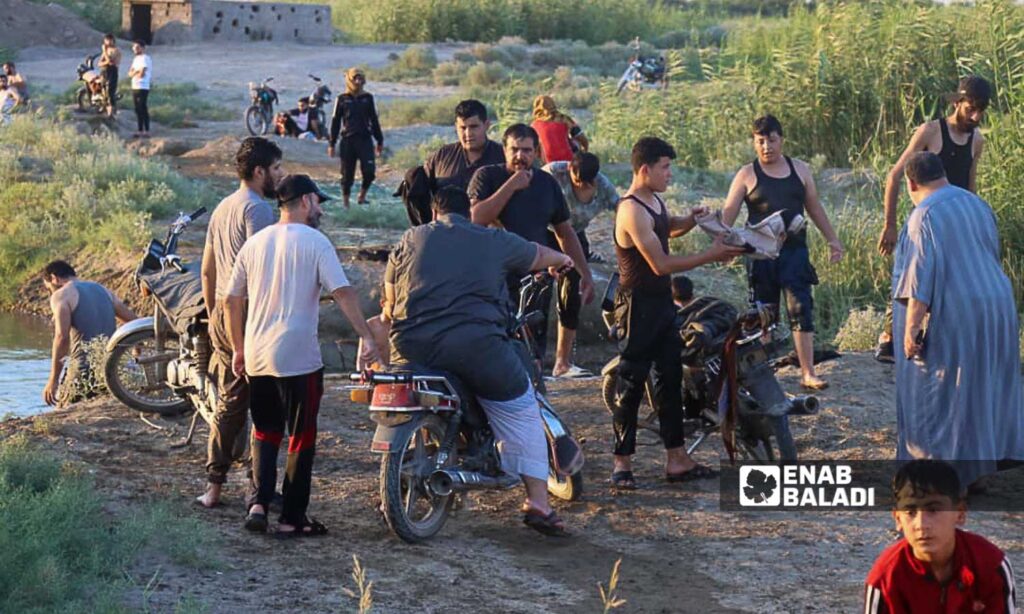Deir Ezzor – Obadah al-Sheikh
Drowning incidents in the Euphrates River have increased significantly since the start of summer, in the governorate and countryside of Deir Ezzor, eastern Syria.
While the Civil Defense Directorate in the areas controlled by the regime in Deir Ezzor recorded 21 cases of drowning from the beginning of summer until mid-June, the local website “Deir Ezzor 24” reported that the number of deaths has exceeded 50 cases.
Furthermore, the numbers might be higher than reported, due to the non-intervention of the Autonomous Administration of North and East Syria (AANES) east of the Euphrates in rescue operations or documenting drowning incidents.
The rise in drowning incidents is attributed to several factors, the most prominent being the prolonged power outages amidst high temperatures, which drives residents, especially youths, to the river for swimming to escape the heat, according to residents interviewed by Enab Baladi in Deir Ezzor.
Voices have been raised in mosques during Friday sermons, warning that the region may witness more drowning incidents as temperatures rise, potentially increasing the number of young people heading to the river for swimming.
Power outages and heat waves
Drowning incidents in the Euphrates River are due to the increasing tendency of residents to swim because of the high temperatures in the region, which is accustomed to extreme heat every summer.
Temperatures in Deir Ezzor exceeded 45 degrees Celsius last week, coinciding with continuous power outages, especially in regime-controlled areas where electricity is available for a maximum of two hours a day.
On August 10, the local radio station “Sham FM” reported another drowning incident in the Euphrates River involving a 17-year-old girl, raising the total number of cases to 29 since the beginning of summer, according to an unspecified source.
In June, teenager Ahmed Bashir al-Shabout drowned in the Euphrates River near the town of Abu Hamam, where he hails from, in eastern Deir Ezzor, as documented by local media.
Khalil al-Bashir, a relative of the drowned, told Enab Baladi that relevant authorities should provide designated swimming areas, establish specific swimming hours, and prohibit approaching the river at noon to prevent drowning incidents and heat strokes.
He called for strict measures in this regard to reduce the recurring seasonal drowning incidents in the region as temperatures rise.
Recommendations to avoid risks
Mona al-Abdullah, a nurse at al-Kasra Hospital in eastern Deir Ezzor, told Enab Baladi that the increase in drowning incidents is due to swimmers not recognizing the temperature of the water compared to the outside air temperature.
She added that the water temperature at noon is lower compared to the outside air temperature, which can cause fainting upon exiting and re-entering the river, leading to drowning if the swimmer loses consciousness in the water.
She advised young people to avoid swimming at noon due to the high air temperature and to ensure that swimming areas are well-known in terms of water depth and current speed to avoid life-threatening risks.
The nurse recommended not swimming alone to ensure there is help available in emergency situations.
On June 16, the child Mohamed Murad al-Muhaymid drowned in al-Hisan town in western Deir Ezzor while swimming in the Euphrates River, and his body hasn’t been found to date.
Young men in the Euphrates River region in eastern Deir Ezzor, Syria – July 20, 2024 (Enab Baladi/Obadah al-Sheikh)
Along the Euphrates
Despite the repeated discussions about drowning incidents in the Euphrates River, residents of cities and villages along the river see swimming in the river as an essential activity every summer, according to young people from Raqqa who previously spoke to Enab Baladi.
Young men from Raqqa believe the high drowning rates in the governorate are due to the Autonomous Administration dumping debris on the riverbank, making the spots frequented by youths for swimming deeper.
At the same time, some youths criticize the lack of rescue efforts and response to drowning incidents on the Euphrates River bank.

